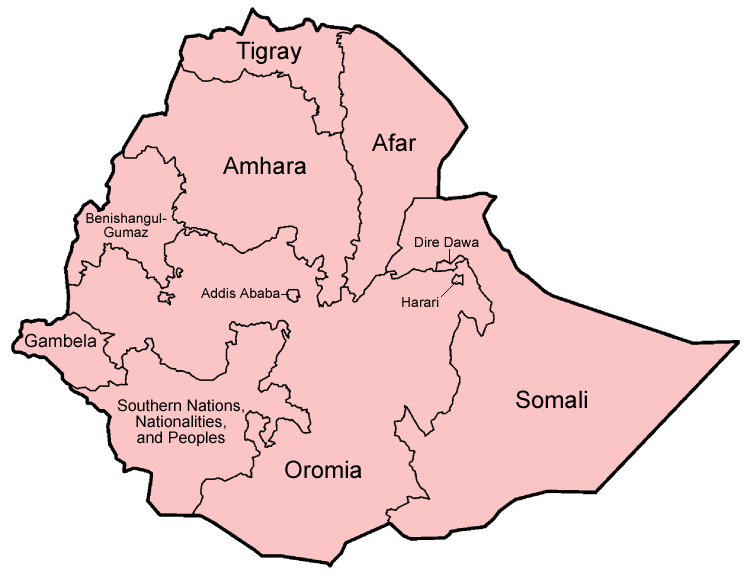Regions of Ethiopia

 |
| This article is part of a series on the politics and government of Ethiopia |
|
|
|
Judiciary
|
|
Related topics |
|
Politics portal |
Since 1995, Ethiopia is constitutionally formed by a federation of nine ethnically-based regional states (plural: kililoch; singular: kilil) and two chartered cities (plural: astedader akababiwach; singular: astedader akabibi). These administrative regions replaced the older system of provinces. The word "kilil" more specifically means "reservation" or "protected area".[1] The ethnic basis of the regions and choice of the word "kilil" has drawn fierce criticism from those in opposition to the ruling party who have drawn comparisons to the bantustans of apartheid South Africa.[2]
The two chartered cities are Addis Ababa and Dire Dawa. Harari, though very small, is a regional state.
Regions are governed by a regional council whose members are directly elected to represent districts (woreda). Each council has a president, who is elected by the council. The regions also have an executive committee, whose members are selected by the president from among the councilors and approved by the council. Each region has a sector bureau, which implements the council mandate and reports to the executive committee.[3]
List of regions
| Map | Flag | Region name | Population[4] | Area (km2)[5] | Density (km2) | Capital |
|---|---|---|---|---|---|---|
| 1 | Addis Ababa (city admin.) and capital city | 2,739,551 | 526.99 | 5,198.49 | N/A | |
| 2 | Afar Region | 1,411,092 | 72,052.78 | 19.58 | Semera | |
| 3 | Amhara Region | 17,214,056 | 154,708.96 | 111.28 | Bahir Dar | |
| 4 | Benishangul-Gumuz Region | 670,847 | 50,698.68 | 13.23 | Asosa | |
| 5 | Dire Dawa (city admin.) | 341,834 | 1,558.61 | 219.32 | N/A | |
| 6 | Gambela Region | 306,916 | 29,782.82 | 10.31 | Gambela | |
| 7 | Harari Region | 183,344 | 333.94 | 549.03 | Harar | |
| 8 | Oromia Region | 27,158,471 | 284,537.84 | 95.45 | Addis Ababa[6] | |
| 9 | Somali Region | 4,439,147 | 279,252 (est.) | 15.90 | Jijiga | |
| 10 | Southern Nations, Nationalities, and Peoples' Region | 15,042,531 | 105,887.18 | 142.06 | Hawassa | |
| 11 | Tigray Region | 4,316,988 | 41,409.95 | 104.19 | Mek'ele |
See also
References
- ↑ Amharic Dictionary. www.amharicdictionary.com. 2012-12-19. https://amharicdictionary.com/index.aspx?EnglishText=&SearchEnglish=Search&AmharicText=%E1%8A%AD%E1%88%8D%E1%88%8D. Accessed: 2012-12-19. (Archived by WebCite® at http://www.webcitation.org/6D1nxuCvk)
- ↑ Demaret, Luc (29 October 2002). "'They knew I would rather die than give up the fight': Interview with Taye Woldesmiate (Ethiopia)". International Labour Organization. Archived from the original on 25 July 2008. Retrieved 15 July 2012.
'Since 1993, the education system has been substantially decentralised, with responsibility passing to the provincial authorities.' ... as Taye Woldesmiate went on to point out, the government 'decided to use education policy to promote its own political agenda, meaning its ethnic policy to divide the country'. At the time, teachers denounced this shift. 'The regime created apartheid-type Bantustan states called "killils", or homelands. Citizens are confined within their "killils" never to seek education or jobs outside their homeland', they said.
- ↑ Yilmaz, Serdar; Venugopal, Varsha (2008). Local Government Discretion and Accountability in Ethiopia (PDF). Working Paper 08-38. International Studies Program, Andrew Young School of Policy Studies, Georgia State University. pp. 4–5. Retrieved 22 June 2013.
- ↑ Census 2007 Tables
- ↑ 2011 National Statistics
- ↑ "The Oromia National Regional State". Government of Ethiopia. 2012. Archived from the original on 15 August 2014. Retrieved 29 April 2015.
External links
| ||||||||||||||||||||||||||||||||||||||||||||||||||||||
| ||||||||||||||
| ||||||||||